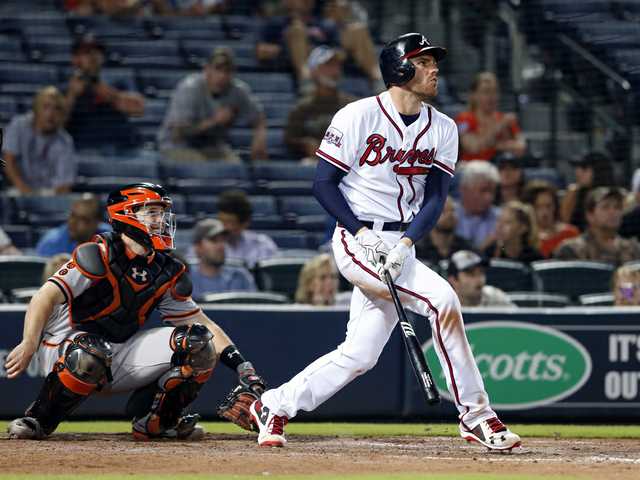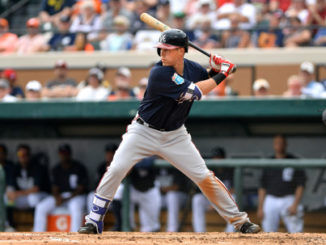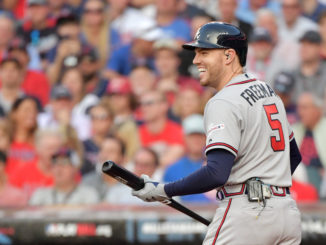2016 Post-Mortem will take a look at each position, how it fared in 2016, and where the team is set to go in the future. Previous Post-Mortems: Catcher.
| Player | BA | OBP | SLG | Comb. WAR |
|---|---|---|---|---|
| Freddie Freeman | .302 | .400 | .569 | 6.5 |
| Blake Lalli | .154 | .154 | .231 | -0.2 |
| TOTAL | .300 | .397 | .567 | 6.3 |
Freddie Freeman

2016 wasn’t a banner year for Braves baseball, but it was for the team’s franchise 1st baseman. Freeman, who turned 27 in September, had a breakthrough that was anticipated for several years. He set career highs in nearly every offensive statistic. That includes strikeouts and strikeout rate, which for Freeman was a good thing. Yes, it was bad for the plate appearances that resulted in Ks, but the general approach, where he wasn’t as afraid to strike out, allowed him to hit the ball harder when he made contact. It resulted in a career high in % of batted balls classified as “hard hit” by Baseball Info Solutions. I’m normally wary of engineered stat lists like the one I’m about to throw at you, but I’m doing it anyway, just because: only 23 players in big league history have had a season in which they had at least a .400 OBP, 40 doubles, 5 triples, and 30 homers. Of the 23, 13 are in the HOF, and it’s a shortlist of some of the greatest hitters ever: Al Simmons, Babe Ruth, Chuck Klein, Earl Averill, Hank Aaron, Hank Greenberg, Jim Bottomley, Joe Dimaggio, Joe Medwick, Lou Gehrig, Rogers Hornsby, Stan Musial, and Ted Williams. The other 10 are Babe Herman, Barry Bonds, Ellis Burks, Jason Bay, Jeff Kent, Lance Berkman, Matt Holliday, Rudy York, Todd Helton, and, now, Freddie Freeman. The parameters were arbitrarily chosen to include Freeman, sure, but it’s an undeniably special season he had. It’s been 9 years since any major-leaguer did that.
The big question, going forward, is whether it was a one-year career year for Freeman or the beginning of a new era for the Braves star. It could be a bit of both. Freeman saw and hit the ball so well in the latter part of the year (and Matt Kemp wasn’t the reason), I don’t think it’s unreasonable to expect him to come back to earth a bit. That being said, he took some steps forward that could prolong his success:
- He walked more. Freeman’s 12.8% walk rate was his career high. It was by a relatively narrow margin over his 2014 walk rate, but it was his high point nonetheless. This lets us know that the increased strikeouts had more to do with Freeman making higher-impact swings than it did with him chasing pitches out of the zone.
- His ISO spiked. ISO is ‘isolated slugging’, or simply Slugging Percentage minus Batting Average. It takes singles out of slugging percentage, giving us a better idea as to how much of the SLG was due to, you know, slugging. His prior career high was .196, but in 2016 it was .267. To give some historical perspective, his best previous year in this department saw him have power similar to Boog Powell or Carlos Santana (career .196 ISOs). In 2016, it was more like Carlos Delgado (.266) or Albert Belle (.269). That’s a pretty significant difference.
- His HR/FB rate spiked as well. Nearly 1 out of every 5 flyballs Freeman hit in 2016 left the park. That was, unsurprisingly, the highest rate of his career. This is often an indicator of an increase in power, and HR/FB rate has strong correlation from year to year.
When you consider that he just turned 27, I think it’s perfectly reasonable to expect Freeman to remain one of the most valuable 1B in the game. His defense should remain reliably strong, and if the bat can stay in the Rizzo/Goldschmidt echelon, Atlanta can enjoy an offensive cornerstone for years to come. Freeman is signed for the next 5 years at $106.5M. If he plays like he did in 2016, that’ll be an enormous bargain.
Blake Lalli
Blake Lalli isn’t a first baseman, but he played one on TV in 2016. His normal trade is that of a AAA catcher. Lalli first became a AAA catcher in 2012 with the Cubs, and performed in the same role that year for the A’s. In 2013, he was a AAA catcher for the Brewers. In 2014 and 2015, he was a AAA catcher for the Diamondbacks. Are you getting the gist of it? Play in AAA all year, and hopefully get called up in September to do menial tasks like catching in the bullpen or giving Freddie Freeman a day off. There are worse ways to go through life. Lalli even got his first MLB extra-base hit this year, a double. He’ll turn 34 next year, and considering he just signed a minor league deal for 2017 with the Braves, he’s likely to do it in lovely Buford, GA, in the role he’s best suited for – AAA catcher.
What’s Next
5 more years of Freddie Freeman, that’s what! And given how durable he’s generally been, there’s not much more the team needs to plan for. The Braves are seemingly set at first base. The team may not be very good, but this spot on the roster unquestionably is.




Leave a Reply